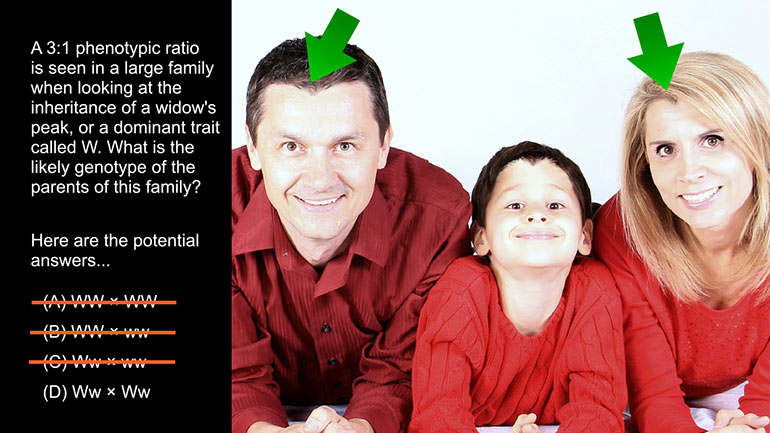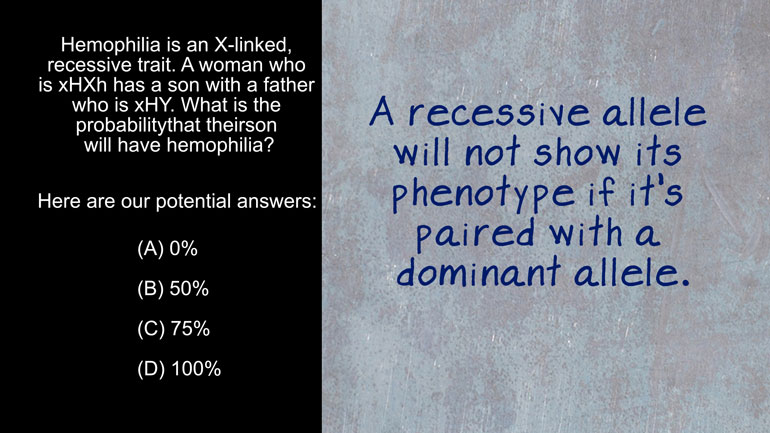ShmoopTube
Where Monty Python meets your 10th grade teacher.
Search Thousands of Shmoop Videos
Phenotypic variation and fitness Videos 5 videos
AP Biology: Essential Life Process Information Drill 1, Problem 1. If one parent is heterozygous for the sickle cell trait while the other par...
AP Biology 1.2 Essential Life Process Information. What is likely the genotype of the parents of this family?
AP Biology 1.4 Essential Life Process Information. A 1:2:1 phenotypic ratio is the hallmark of what type of cross?
AP Biology 3.1 Evolution 16 Views
Share It!
Description:
AP Biology 3.1 Evolution. What is the study of structural similarities before an animal is born called?
Transcript
- 00:04
Here’s your Shmoop du jour, brought to you by similarities, the worst thing that could
- 00:08
happen to someone who wants to stand out from the crowd. [Girl with pink hair walks past another girl with pink hair]
- 00:10
Check out the following statement:
- 00:13
The study of structural similarities before an animal is born is called this.
- 00:18
And here are the potential answers: Structural similarities are factors that indicate
Full Transcript
- 00:25
species are closely related and may have evolved from a common ancestor. [Monkeys driving a pink car]
- 00:30
It does not, however, prove that we are all somehow related to the Kardashians.
- 00:35
We'll get over that crushing disappointment somehow.
- 00:37
All right, if you chose “A,” then you don’t know a bat’s wing from your left [A man raises his left arm and a bats wing appears underneath]
- 00:41
arm, both of which happen to be examples of homologous structures.
- 00:45
They're similar in anatomy, but not necessarily in function.
- 00:48
While the anatomical similarity part might sound promising, answer A has nothing to do [Hand shaking a bottle of prenatal tablets]
- 00:52
with anything prenatal.
- 00:54
So “A” is incorrect.
- 00:56
Vestigial organs are useless body parts.
- 00:59
Like the top skin fold on your ear, or your wisdom teeth. [A man with an x-ray of his mouth and an arrow pointing to a wisdom tooth]
- 01:03
Considering your teeth aren't going to help you figure this question out, we can safely
- 01:07
eliminate answer C. How about B?
- 01:10
Well biogeography is a study, but it researches the geographic distribution of plants and animals
- 01:16
Biogeographers have this intense need to know why birds are rarely seen at the mall. [A bird walking through a store]
- 01:21
It's mostly because they're so...cheep...
- 01:23
And that's it for B?
- 01:25
It's so wrong.
- 01:27
That brings us to comparative embryology, which is the study of structural similarities [A cracked egg with an embryo inside]
- 01:31
before an animal is born.
- 01:33
Ringing any bells?
- 01:35
Aristotle is recognized as the first person to compare embryos of different species in [Aristotle looking under a microscope]
- 01:40
an effort to prove that all animals are somehow structurally related.
- 01:44
The Greek philosopher was also the first to know the correct answer to our question is [Aristotle stood with the letter D]
- 01:48
“D,” comparative embryology.
- 01:50
If you chose “D”, you're practically the next Aristotle.
- 01:54
Or, as we like to think of it, Aristotle 2: Electric Boogaloo. [Aristotle with a guy and girl performing dance moves]
Related Videos
AP Biology: Biological System Interactions Drill 1, Problem 1. Complete the sentence about a saturated fatty acid.
AP Biology: Essential Life Process Information Drill 1, Problem 1. If one parent is heterozygous for the sickle cell trait while the other par...
AP Biology: Evolution Drives the Diversity and Unity of Life Drill 1, Problem 1. The first cells on planet Earth were likely what?
AP Biology: Free Energy and Molecular Building Blocks Drill 1, Problem 1. Which statement incorrectly describes the properties of water?
AP® Biology: Evolution Drives the Diversity and Unity of Life Drill 1, Problem 2. What was likely the first genetic material?








